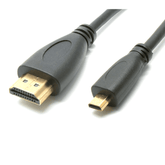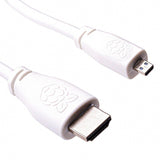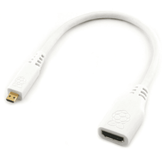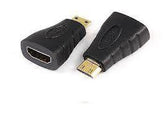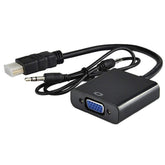Understanding HDMI: Everything You Need to Know About Connectors
Summary
Dive into the world of HDMI with our comprehensive guide! From its introduction to understanding its significance, we unravel the complexities of HDMI standards, connector types, pin configurations, and cable varieties. Whether you're a tech enthusiast or a novice, this breakdown equips you with the knowledge to navigate HDMI seamlessly. Explore design considerations and unlock the potential of your devices. Join us as we unravel the mysteries of HDMI, demystifying connectors and empowering your digital experiences. Don't miss out – discover the power of HDMI today!
Introduction
Raise your hand if you've ever dealt with a rat's nest of cables behind your TV stand. We've all been there - cursing under our breath as we try to untangle the wires and get our home theater system up and running.
The cable clutter was a necessary evil as audio/video technology advanced rapidly through the decades. It all started with those classic red, white, and yellow Composite RCA cables back in the 1950s.
Those three humble cables carrying analog audio and video signals were simple enough for watching TV, but fast forward a few decades and we're juggling an overwhelming variety of cables just to get picture AND sound?
VGA for computers, S-Video and Component for slightly better quality - it was a headache keeping track of which cables served what purpose. The 1990s brought digital video into the mix with the DVI (Digital Visual Interface) connector.
While a step up from analog, even DVI still required an A/V version of "bromancing" with up to 5 separate cables to allow audio and video signals to play nice together in a home theater setup. Unruly cable spaghetti remained the norm.
The Significance of HDMI
Then HDMI (High-Definition Multimedia Interface) came along in 2002 like a relationship counselor for our cables.
"Why can't we all just get along?" it asked, and bam - audio and video finally tied the knot and combined forces over a single, unified cable.
No more dodging trip-wires behind the entertainment center. No more wondering why your audio was coming through but no picture (or vice versa).

HDMI was the real MVPlug (Most Valuable Plug), and it quickly became the apple of every home-theater enthusiast's eye.
But HDMI wasn't just a one-hit wonder that solved cable clutter. Its underlying technology allowed it to raise the bar for audio/video quality and capabilities through subsequent revised specifications.
HDMI established a universal language that enabled seamless interoperability between devices from different manufacturers.
It streamlined home installations while elevating audio/video fidelity to new heights.
Its versatility and future-proofing allowed HDMI to become the de facto connector treaty for every A/V device under the sun.
HDMI Standards Overview
HDMI 1.0
The original HDMI 1.0 specification from 2002 had manufacturers breathing a sigh of relief. Finally, a way to streamline connections between their audio/video gear without sacrificing quality.

HDMI 1.0 supported higher resolutions up to 1080p and could carry uncompressed digital video/audio over a single cable. It was the total A/V package.
Progression of HDMI Standards
As displays and content rapidly pushed resolution and feature limits, the HDMI specification leveled up time and time again:
| Version | Max Speed | Headline Features |
|---|---|---|
| 1.0 | 4.95 Gbps | 1080p support paved the way for HD |
| 1.3 | 10.2 Gbps | Deep Color support gave images gutsy, vivid colors |
| 1.4 | 10.2 Gbps | 3D video?! Whoa, didn't see that coming |
| 2.0 | 18 Gbps | Support for 4K video @ 60Hz became possible |
| 2.1 | 48 Gbps | Beast mode unlocked: 8K, HDR, advanced gaming features |
With each iteration, HDMI broadened its capabilities while maintaining backwards compatibility with previous versions - a critical advantage that prevented hardware from becoming obsolete.
HDMI 2.1
The cutting-edge HDMI 2.1 specification from 2017 is the cream of the crop. Resolutions up to a mind-blowing 10K? Check. Color depth and HDR that will blow your socks off with its vibrant, lifelike quality?
You know it. Toss in advanced gaming features like variable refresh rate to eliminate screen tearing, and this beast future-proofs your home theater setup for the foreseeable future.

The best part? HDMI 2.1 plays nice with older A/V gear that uses previous HDMI versions, just like that easygoing friend who gets along with everyone.
Its backwards compatibility prevents you from feeling stuck in the past just because you invested in state-of-the-art equipment years ago.
HDMI Connector Types
While most people are familiar with the standard HDMI connector, the specification actually defines several different form factors to cater to different devices and applications. If HDMI connectors were breakfast cereals:
Type A (Standard)
Type A would be that classic, no-frills-but-gets-the-job-done kind. It's the original 19-pin HDMI layout we all know and love, measuring a humble 13.9mm x 4.45mm.
Type A is the HDMI connector you'll find on most TVs, Blu-Ray players, game consoles, and other home theater gear.
Type B (Dual Link)
Type B is the parental dream of more power...but at what cost? This 29-pin variant aimed to support ultra high-resolution displays and deep color depths, but its hulking 21.2mm x 4.45mm size forced it into permanent time-out.
Too big and complex to be practical for most applications. Maybe the next HDMI generation will give it a second chance.
Type C (Mini) and D (Micro)
As our devices transitioned from boomboxes to palmtops, HDMI connectors got compact with the Mini (Type C) and Micro (Type D) variants.
Think snack-sized versions of the standard Type A layout for portable gadgets like tablets and smartphones.
Mini HDMI measures 10.42mm x 2.42mm while Micro is a tiny 5.83mm x 2.2mm, but both pack the same 19-pin punch as their full-sized counterpart.
Type E (Automotive)
This one's built for a rougher crowd - the automotive realm. Type E comes strapped with an optional locking feature to prevent pesky vibrations from causing disconnects.
Its rugged exterior also shrugs off moisture and dirt ingress like a champ. An alter-ego "relay" version exists to allow automotive HDMI to interface with standard consumer A/V gear.

Connector Variations
To cater to different installation needs, HDMI hooks you up with male and female connector body options for plugging and receptacle duties.
Want it straight or angled to fight tight spaces? Available in both orientations. There are even ruggedized variations built for harsh industrial applications, because HDMI don't judge. It aims to please every possible use case.
Pin Configs & Cable Types
Pin Configurations
Under the hood, most HDMI connectors rock the now-familiar 19-pin layout that maps data channels for video and audio, clock signals for synchronization, power, and control signals like hot plug detect.
Getting this wiring scheme right is critical to ensure proper operation and avoid any undefined behavior (read: nasty A/V bugs).
Some high-end HDMI connectors go beyond 19 pins. The aforementioned Type B Dual Link variant used 29 pins to enable higher resolutions, while Type E for automotive applications includes additional pins for functions like lighting control.
Cable Types
When it comes to HDMI cables themselves, one size definitely does not fit all applications:
- Standard (Category 1): Your basic, entry-level HDMI cable intended for typical audio/video duties like 1080p.
- High-Speed (Category 2): This puppy unlocks the full potential of HDMI with higher bandwidth for data-intensive 4K and HDR video. A must for premium home theater installations.
- Ethernet-enabled: Some HDMI cables have a clever bonus - embedded Ethernet channels to combine video and network data over the same cable. Music to any smart TV's ears for smooth streaming.
- Automotive Grade: Built extra tough and shielded to withstand the vibrations, temperature extremes, and EMI found in automotive environments.
No matter which cable you choose, the HDMI specification mandates that all certified cables must fully enable the capabilities of each HDMI version. No cutting corners allowed.
Design Considerations
PCB & Signal Integrity
Routing those high-speed HDMI signals on printed circuit boards is an art form that demands careful PCB layout techniques.
Designers must employ strategies to dodge crosstalk gremlins and maintain razor-sharp signal integrity over the differential data paths.
Techniques like tight channel-to-channel spacing and tightly coupled differential pairs help fight electromagnetic interference.
Twisted pairs deserve special tender loving care as well to avoid excessive signal loss and degradation over longer trace lengths.
Proper impedance matching through the entire channel is also crucial. HDMI's specified 100 ohm differential impedance must be hitting the sweet spot to reduce signal reflections that could distort the video and audio data.
Careful management of PCB stack-ups, material selections, and copper geometry is required to make this possible. Premium PCB materials like tightly woven glass fabrics help reduce roughness that can negatively impact impedance profiles.
Transmission Limits
As powerful as HDMI technology is, it cannot transmit signals indefinitely without running out of steam.
The high-bandwidth HDMI 2.1 specification sets a maximum limit of around 5 meters (16 feet) for passive cables at the highest 48 Gbps throughput.
But don't panic - just call in an active signal extender, repeater, or fiber optic HDMI cable to buffalo that 300-foot HDMI link across your mansion. With a bit of application engineering,
HDMI is still quite capable of delivering pristine uncompressed audio and video no matter the distance between source and sink devices.
Multiple Device Limits
For all its versatility, HDMI was designed primarily as a point-to-point connection between two devices - a transmitter and receiver. It unfortunately cannot natively broadcast its signal to multiple devices simultaneously.
HDMI is also not equipped to juggle different types of audio streams at once like surround sound and stereo simultaneously.
You'll need to choose which audio output format to prioritize for a given HDMI link. Some boundaries still remain for native HDMI...for now at least. But the march of technological progress continues unabated as the specification is updated.
Conclusion
There's no denying the impact HDMI has made in streamlining and consolidating audio/video connectivity.
It simplified the nightmare of tangled cable bundles behind home installations while simultaneously elevating audio/video fidelity and capabilities to new heights unimaginable in the analog days.
But HDMI represented more than just those physical benefits. Its underlying technology enabled seamless interoperability between A/V devices from different manufacturers.
It established a universal language and specification that prevented proprietary cable chaos. Most importantly,
HDMI flexed enough versatility through evolving standards to keep pace with disruptive innovations like 4K, HDR, and immersive audio formats.
It future-proofed itself to become the preeminent de facto interface for every device with video output under the sun.
Recognizing the significance and longevity of HDMI, CUI Devices is strapped and ready to deliver with its lineup of HDMI 2.0 receptacles.
These products aim to blend cutting-edge HDMI compatibility with CUI's tried-and-true design fundamentals and quality reputation.
CUI's HDMI connector offerings serve as a vehicle to provide modern designers across industries with innovative yet accessible interconnect solutions.
As display and multimedia technologies accelerate, HDMI remains the enlightened path forward - and CUI stands ready to light that path. The torch is lit, so let's keep this HDMI renaissance blazing.



